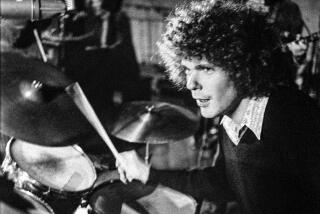‘Greatest Generation’ Was Tested by Times
When I asked 80-year-old Reg Hammond whether his generation really was the greatest generation, as advertised, he did not leap from his chair in sputtering denial.
And how could he? After all, Hammond is one of 50 people profiled in Tom Brokaw’s “The Greatest Generation”--a tribute to Americans of the Depression and World War II.
As the book sat atop the best-seller lists, Hammond, trim and white-haired, sat in his Fillmore study, groping for a few words to describe just what it was that set his crowd apart from me and my millions of fellow baby boomers.
Octogenarians given to bluntness might have said something like: “Well, you’re a bunch of selfish twerps who believe in nothing more precious than the IRAs you’re cultivating for your cold and joyless golden years.” But Hammond is a man of the cloth and more merciful than that.
“People rise to the occasion,” he said. “Maybe we had more to rise to at the time.”
Brokaw couldn’t have put it better. Riding the same tide of gratitude as “Saving Private Ryan,” the NBC anchor wanted to honor “men and women whose everyday lives of duty, honor, achievement, and courage gave us the world we have today.”
Some time back, one of his researchers came across a newspaper story about Hammond’s rise at the age of 79 to the priesthood of an Episcopalian breakaway group called the Anglican Orthodox Church. The article also detailed his service as an artilleryman slogging across Europe from Normandy to Czechoslovakia.
The next thing Hammond knew, he was interviewed for the section of the book labeled “Ordinary People.” (Newly retired Assemblyman Nao Takasugi was featured in a section on the internment camps for Japanese Americans. It was labeled, appropriately, “Shame.”)
Hammond’s father was an Episcopal priest in Ventura and his four brothers became Episcopal priests. He is a man who has never questioned the existence of God--and who grew more certain as he tramped with other ordinary men into the ordinary horrors of war.
There were the bombs and the strafing, the shrapnel that tore through Hammond’s pant leg without piercing his flesh.
There were roadsides dotted with the bodies of American soldiers who should have been getting their first jobs at the mills and the car lots back in their hometowns.
There was the Falaise Gap: “You could hardly step without stepping on something dead,” he recalled. “There were dead horses from the German artillery wagons. There were dead men.”
How can faith thrive in such bleakness?
Hammond answered without hesitation.
“If you think that’s all there is, then you might as well go out and shoot yourself,” he said. “There has to be more to life than just that.”
Of course, there was.
After the war, Hammond took a succession of school administrative jobs around California as he and his wife, Marge, raised two boys. When Marge’s parents became ill, the Hammonds moved from Marin County to their eight-acre citrus ranch outside Fillmore.
All the while, his interest in religion grew, as did his disenchantment with what he saw as the increasingly secular, decreasingly spiritual Episcopal church.
“They tried to make worship more palatable,” he said regretfully. “They watered it down. They grew more concerned with man’s attitude toward man than man’s attitude toward God.”
The church has grown blase about adultery, he charged.
“It used to be considered a sin, but there’s a far greater acceptance of it on the part of the mainstream church today.”
Then there is the ordination of women: “The reason they did it is because of the women’s movement--and that’s not a sufficient reason, not a scriptural reason.”
Seven years ago, Hammond and his wife and a few friends started St. George’s Anglican Church. The 60-member congregation meets in a chapel at Ventura’s Seventh-day Adventist Church. It hews to the 1928 Book of Common Prayer--not the mainstream’s 1979 revision that Hammond fumes at for slackening the church’s spiritual values.
Two years ago, at an age when most other men consider their life’s work done, he became the oldest priest in the Anglican Orthodox Church.
“There was a need,” he said. “You can’t just hire someone off the street for this.”
On Tuesday, he scanned his annual report for 1998--the first full year of his priesthood. He made 11 trips to hospitals and nursing homes, and 31 visits to shut-ins. He officiated at four funerals and assisted at one. He performed two weddings and two baptisms and prepared two people for confirmation.
It’s little wonder he didn’t have time to see “Saving Private Ryan.”
On the other hand, maybe he didn’t have to.
Steve Chawkins is a Times staff writer. His e-mail address is [email protected]
More to Read
Sign up for Essential California
The most important California stories and recommendations in your inbox every morning.
You may occasionally receive promotional content from the Los Angeles Times.











